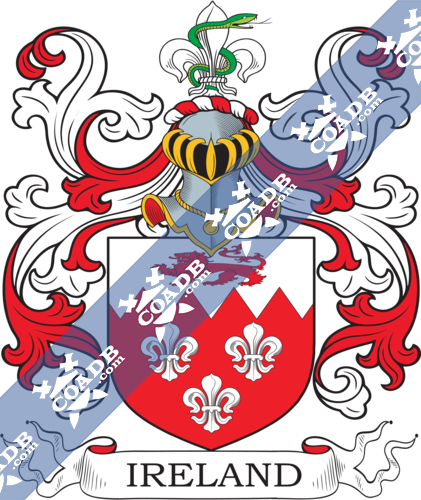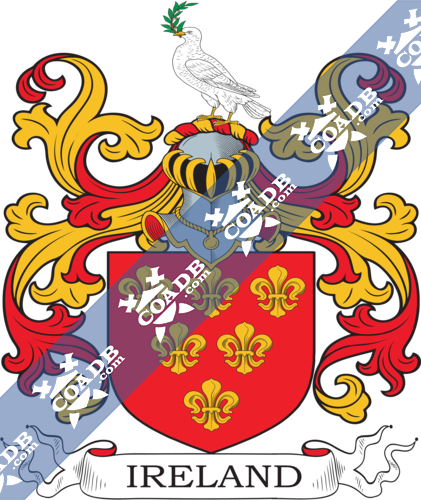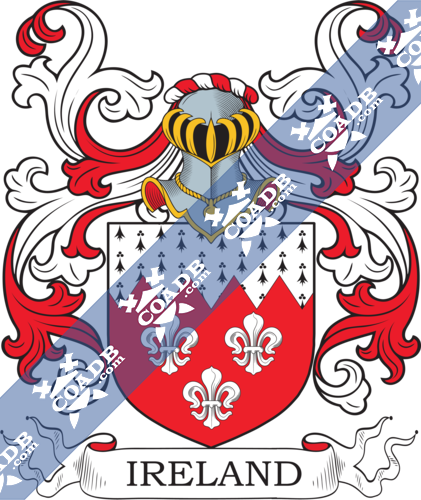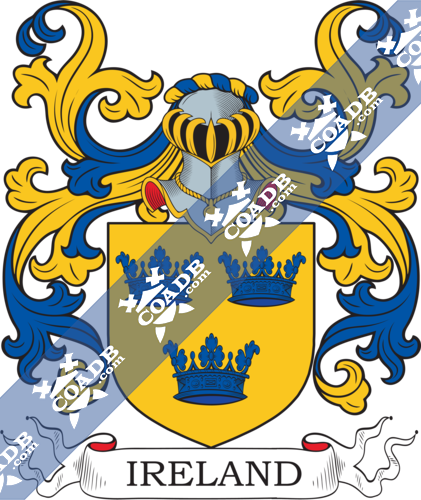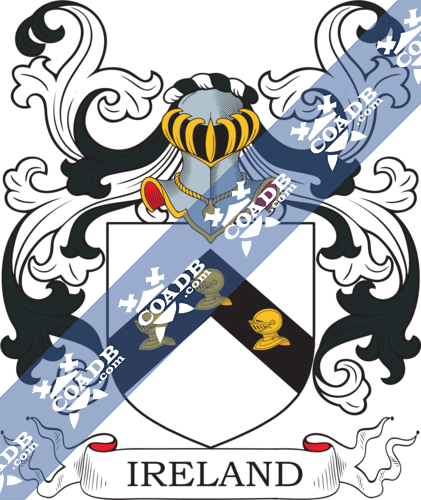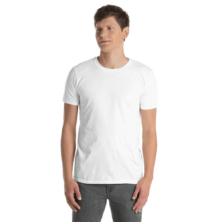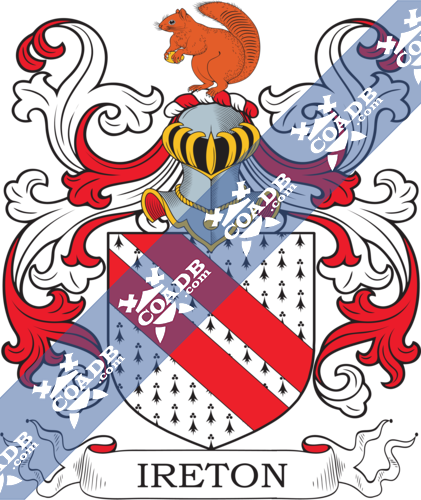Ireland Family Crest, Coat of Arms and Name History
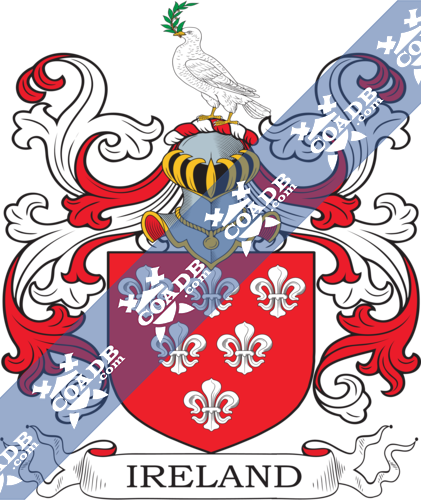
Ireland Coat of Arms Gallery
Don’t know which Coat of Arms is yours?
We can do a genealogical research. Find out the exact history of your family!
Learn MoreIRELAND
English in origin the surname Ireland comes from the medieval English compound word “Iraland”. The prefix of the word “Iras” translated to Irishman and “land” translated as it sounded, land or region. In this context the name would be topographical as it was used in reference to an inhabitant of Ireland.
In Europe, the majority of what would later come to be surnames were little more than descriptors or identifiers up until the late 16th to early 17th centuries. Until this period in time, only those of nobility had what would be considered proper surnames. Due to the small size of settlements and villages which existed during earlier times, residents found little need for surnames as everyone in these communities new each other and a given name would usually suffice. However, with the passage of time, population growth and expansions of communities as villages gave way to towns and cities, it became necessary to add a qualifier to a people’s names to distinguish them, one from another. Therefore one person may have been identified by their given name plus their occupation while another may have been identified by their given name and one of their parent’s names. There was a limitless supply from which surnames could be formed, in addition to the use of patriarchal/matriarchal names or reference to the individuals occupation, there were things such as defining physical traits, a familiar geographical location or a topographical landmark found near the individuals home or birthplace, the name of the village in which the person lived, and so much more. The practice of using surnames also served another practical purpose, it gave governments a reliable way to track people for tax and census purposes.
Many of the earliest recordings of surnames are found in official church records and government documents. One of the earliest recordings of any variation of the name Ireland is that of Richard Ireis found in the Shropshire tax rolls dated 1169. These rolls, were a series of census and tax records kept by the English Treasury by order of Queen Henry II, with the oldest dating back to the 12th century.
One noted issue with the record keeping of this era is the variations in the spelling of surnames, this is attributed to a lack of consistency regarding guidelines for spelling in use by the scribes who recorded such information dating back to ancient times. In addition, many of these record keepers were in the habit of spelling phonetically, however, what may have sounded one way to one person may have sounded completely different to another. Due to these issues, variations in the name can include, but are not limited to; Ireland; Irish; Ierland; and Iroland as well as others.
After the founding of America, Canada, and other lands abroad, migration began to occur in greater volume than ever before. Some of the first immigrants to America were Martha Ireland and her children, Mary, Samuel, and Thomas who landed and settled in Boston, Massachusetts in 1635. George Ireland was one of the early immigrants to Australia, settling in Adelaide in 1850. John de Courcy Ireland was one of the early settlers to New Zealand, settling in Auckland in1840.
Worldwide, the highest concentration of people with the surname Ireland are found in Australia, New Zealand, the United Kingdom, Canada, and the United States. By state, the largest percentile of those with the surname Ireland live in Maine, Idaho, Kansas, and South Dakota.
There are many notable people with the surname Ireland. David Kenneth Ireland was born in Bellingham, Washington, he was a noted minimalist architect, sculptor, and conceptual artist.
He received his education at the California College of Arts and Crafts, Western Washington University, San Francisco Art Institute, and Laney College. During his career, Ireland won many awards including the N.E.A Artist Fellowship grant, Adaline Kent Award, the Engelhard Award, and the American Academy of Art.
Blazons & Genealogy Notes
1) (Hutt and Hale, co. Lancaster; deacended from Sir John de Ireland, temp. William I.; the last male heir In the direct line, Sir Gilbert Ireland, M.P. for Liverpool, son and heir of Sir John de Ireland, Knt., of Hutt and Hale, d. 1676, leaving his two sisters his co-heirs, m. Green and Aspinwall, now represented by Blackburne, of Hale). Motto—Amor et pax. (Robertstown, co. Kildare; a branch of the Irelands, of the Hutt and Hale; derived from William Ireland, son of George Ireland, who is said to have been brother of Sir John de Ireland, the father of the great Sir Gilbert Ireland, of the Hutt and Hale). Gu. six fleurs-de-lis, three, two, and one ar. Crest—A dove and olive branch ppt.
2) (Lydiate, co. Lancaster; descended from Thomas, second son of Sir John de Ireland, of Hutt and Hale). Gu. a spear in bend or, headed ar. the head pointing to the sinister base point, at the other end a pennon pendant of the third betw. six fleurs-de-lis of the last, all within a bordure engr. of the second pellettee.
3) (cos. Hertford and Salop; granted 1601). Gu. three fleurs-de-lis ar. on a chief indented of the last a lion pass. of the first. Crest—A fleur-de-lis ar. entwined with a snake reguard. vert perforating the middle leaf of the fleur.
4) (Owsden Hall, co. Suffolk). Gu. six fleurs-de-lis, three, two, and one or. Crest—A dove and olive branch ppr.
5) (co. Surrey). Ar. a chev. erm. betw, three mullets gu.
6) (granted 1601). Gu. three fleurs-de-lis ar. a chief indented erm.
7) Or, three crowns az.
8) Gu. a fleur-de-lis ar.
9) Ar. on a chev. sa. three helmets close or.


